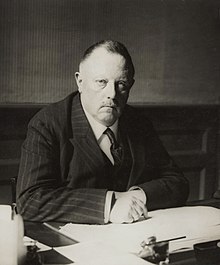Willem Hendrik Keesom: Difference between revisions
Appearance
Content deleted Content added
+ image |
Rescuing 1 sources and tagging 0 as dead. #IABot (v1.6.1) (Balon Greyjoy) |
||
| Line 41: | Line 41: | ||
==External links== |
==External links== |
||
* Albert van Helden, [http://www.historyofscience.nl/author.cfm?RecordId=260 ''Willem Hendrik Keesom 1876 – 1956''], In: K. van Berkel, A. van Helden and L. Palm ed., A History of Science in the Netherlands. Survey, Themes and Reference (Leiden: Brill, 1999) 498-500. |
* Albert van Helden, [http://www.historyofscience.nl/author.cfm?RecordId=260 ''Willem Hendrik Keesom 1876 – 1956''], In: K. van Berkel, A. van Helden and L. Palm ed., A History of Science in the Netherlands. Survey, Themes and Reference (Leiden: Brill, 1999) 498-500. |
||
* Scientists of the Dutch School: [http://www.knaw.nl/waals/keesom.html ''Willem Hendrik Keesom''] @ Royal Netherlands Academy of Arts and Sciences. |
* Scientists of the Dutch School: [https://web.archive.org/web/20041216202440/http://www.knaw.nl/waals/keesom.html ''Willem Hendrik Keesom''] @ Royal Netherlands Academy of Arts and Sciences. |
||
* P.H. van Laer, [http://www.inghist.nl/Onderzoek/Projecten/BWN/lemmata/bwn1/keesom ''Keesom, Wilhelmus Hendrikus (1876-1956)''], in Biografisch Woordenboek van Nederland. |
* P.H. van Laer, [http://www.inghist.nl/Onderzoek/Projecten/BWN/lemmata/bwn1/keesom ''Keesom, Wilhelmus Hendrikus (1876-1956)''], in Biografisch Woordenboek van Nederland. |
||
Revision as of 03:19, 28 November 2017
Willem Keesom | |
|---|---|
 | |
| Born | 21 June 1876 |
| Died | 24 March 1956 (aged 79) |
| Nationality | Dutch |
| Known for | helium |
| Scientific career | |
| Fields | physics |
| Doctoral advisor | Johannes Diderik van der Waals |
Willem Hendrik Keesom (/ˈkeɪsoʊm/[1][2]) (21 June 1876, Texel – 24 March 1956, Leiden) was a Dutch physicist who, in 1926, invented a method to freeze liquid helium. He also developed the first mathematical description of dipole-dipole interactions in 1921. Thus, dipole-dipole interactions are also known as Keesom interactions. He was previously a student of Heike Kamerlingh Onnes, who had discovered superconductivity (a feat for which Kamerlingh Onnes received the 1913 Nobel Prize in Physics).
He also discovered the lambda-point transition specific-heat maximum between Helium-I and Helium-2 in 1930 (Basic Superfluids p25/Tony Guenault).
In 1924 he became member of the Royal Netherlands Academy of Arts and Sciences.[3]
See also
References
- ^ Willem Hendrik Keesom pronunciation
- ^ Voiceless E
- ^ "Willem Hendrik Keesom (1876 - 1956)". Royal Netherlands Academy of Arts and Sciences. Retrieved 28 July 2015.
External links
- Albert van Helden, Willem Hendrik Keesom 1876 – 1956, In: K. van Berkel, A. van Helden and L. Palm ed., A History of Science in the Netherlands. Survey, Themes and Reference (Leiden: Brill, 1999) 498-500.
- Scientists of the Dutch School: Willem Hendrik Keesom @ Royal Netherlands Academy of Arts and Sciences.
- P.H. van Laer, Keesom, Wilhelmus Hendrikus (1876-1956), in Biografisch Woordenboek van Nederland.
